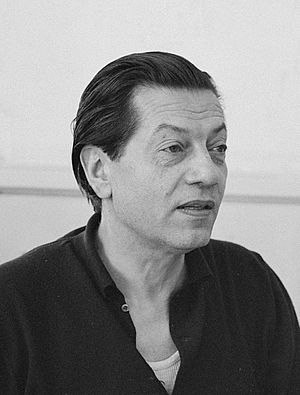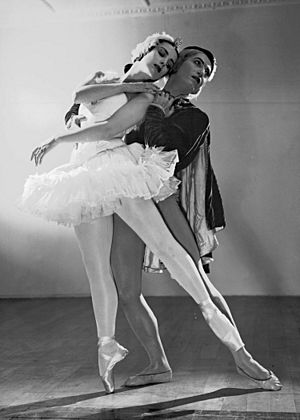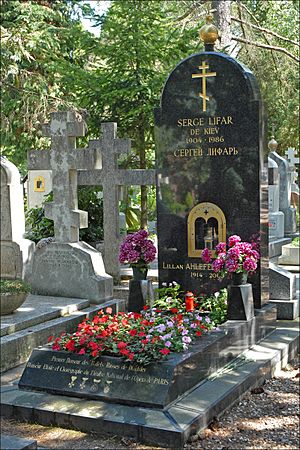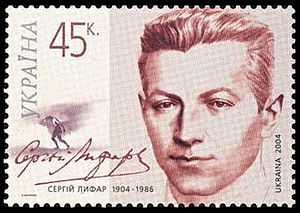Serge Lifar facts for kids
Quick facts for kids
Serge Lifar
|
|
|---|---|
| Сергій Михайлович Лифар | |

Serge Lifar in 1961
|
|
| Born |
Serhіy Mуkhailovуch Lуfar
15 April 1905 |
| Died | 15 December 1986 (aged 81) |
| Nationality | Ukrainian, naturalized French |
| Occupation | ballet dancer, choreographer |
| Known for | Paris Opéra Ballet |


Serge Lifar (Ukrainian: Сергій Михайлович Лифар, Serhіy Mуkhailovуch Lуfar) (April 15, 1905 – December 15, 1986) was a famous Ukrainian ballet dancer and choreographer. He was one of the most important male ballet dancers of the 20th century. Lifar was also a director, writer, and a collector of art.
He worked as the ballet master (the person in charge of ballet performances) at the Paris Opera from 1930 to 1944, and again from 1947 to 1958. He worked hard to make the Paris Opera Ballet one of the best dance companies in the world again.
Contents
Biography
Early Life and Training
Serge Lifar was born in Kyiv, Ukraine. He started learning ballet in Kyiv in 1920. His teacher was Bronislava Nijinska.
In 1921, he left Ukraine and was noticed by Sergei Diaghilev. Diaghilev was a very famous ballet organizer. He sent Lifar to Italy to improve his dance skills.
Joining the Ballets Russes
Lifar joined the famous Ballets Russes company in 1923. By 1925, he became their main male dancer. Many people saw him as the next great dancer after Nijinsky.
He performed in many important ballets for the Ballets Russes. These included La Chatte (1927) and Apollon Musagète (1928). In Apollon Musagète, he played the Greek god Apollo. He also starred in Le Fils prodigue (The Prodigal Son) (1929). This was one of the last big ballets of the Diaghilev era.
Leading the Paris Opéra Ballet
After Diaghilev died in 1929, Lifar was asked to lead the Paris Opéra Ballet. He was only 24 years old. The company was not doing well at the time. Lifar helped bring ballet back to life in France.
He created many successful ballets for the company. Some of his famous works include Les Créatures de Prométhée (1929) and Suite en Blanc (1943). He also worked with famous artists like Pablo Picasso on his ballet Icare (1935).
Lifar wanted to make ballet more exciting. He even added two new foot positions to the traditional five positions. These were called the sixth and seventh positions. They were not completely new, but he brought them back from older ballet styles.
During World War II, Lifar continued to lead the Paris Opéra Ballet. It was a very difficult time in France. After the war, he faced some challenges and was temporarily unable to work at the Opera. However, he later returned to his position.
He even took the Paris Opéra Ballet to America. Their performances were very popular. Lifar had a big influence on many dancers, like Yvette Chauviré. In 1958, he retired from his role at the Opera.
Later Life
In 1958, Lifar had a public disagreement with another ballet leader, George de Cuevas. They had an unusual "duel" with swords, but it was more of a public show. Lifar received a small cut on his arm, and they quickly made up.
In 1977, the Paris Opéra Ballet dedicated an entire evening to his ballets. This showed how much they respected his work.
Death
Serge Lifar passed away in Lausanne, Switzerland, on December 15, 1986. He was 81 years old. He was buried in the Sainte-Geneviève-des-Bois Russian Cemetery in France.
Legacy
After his death, Lifar's memories were published in a book called Les Mémoires d'Icare. This title refers to his famous role in the ballet Icare. The ballet tells the ancient Greek story of Icarus. Icarus flew too close to the sun with wings made of wax and feathers.
The Serge Lifar Foundation was started in 1989. It helps support ballet and dance. Jewels from his companion's estate were sold to raise money for the foundation.
Since 1994, the Lifar International Ballet Contest has been held in Ukraine. Young dancers compete in this important event.
Awards and Honours
- Commandeur des Arts et des Lettres (Commander of Arts and Letters)
- Chevalier de la Légion d'honneur (Knight of the Legion of Honor) (1983)
Books and Ideas
In 1935, Lifar wrote a book called Le manifesto du chorégraphe. In this book, he shared his strong beliefs about dance. He believed that ballet should be its own art form. He thought ballet should not just be an illustration of music or painting. He even suggested that ballet could exist without music!
He also wrote a biography about Sergei Diaghilev. The book was called Serge Diaghilev, His Life, His Work, His Legend: An Intimate Biography.
Cultural Depictions
- Anna Pavlova (1983) is a film about the famous ballerina Anna Pavlova. Serge Lifar was played by Igor Sklyar in this movie.
See also
 In Spanish: Serge Lifar para niños
In Spanish: Serge Lifar para niños




